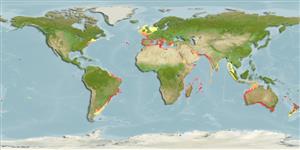Common names from other countries
Classification / Names / Names
Populaire namen | Synoniemen | Catalog of Fishes (gen., sp.) | ITIS | CoL | WoRMS
Environment: milieu / climate zone / depth range / distribution range
Ecologie
Pelagisch; diepteverspreiding 0 - 200 m (Ref. 1134). Subtropical; 15°C - 27°C (Ref. 1134)
Warm waters of all oceans.
Length at first maturity / Size / Gewicht / Leeftijd
Maturity: Lm ? range ? - ? cm Max length : 0.3 cm TL mannelijk/geslacht niet bekend; (Ref. 1610)
Minimum depth from Ref. 3475. Marine, planktonic; not deeper than 200 m (Ref. 1134). Prefers neritic ambience (Ref. 3531).
Life cycle and mating behavior
Geslachtsrijpheid | Voortplanting | Kuitschieten | Eieren | Fecundity | Larven
Members of the class Appendicularia are protandrous hermaphrodites. Life cycle: Eggs develop into hatchlings (feeding juveniles) before turning into adults.
Kott, P. 2005. (Ref. 1134)
Status op de Rode Lijst van het IUCN (Ref. 130435)
Status bij CITES (Ref. 108899)
Not Evaluated
Not Evaluated
Gebruik door de mens
| FishSource |
Tools
Meer informatie
Populaire namenSynoniemenPredatorsVoortplantingGeslachtsrijpheidKuitschietenFecundityEierenOntwikkeling van de eieren
Leeftijd/Grootte
Groei
Lengte-gewicht parameters
Lengte-lengte parameters
Morfologie
Larven
Abundantie
Internet-bronnen
Estimates based on models
Preferred temperature
(Ref.
115969): 15.8 - 26.9, mean 20.6 (based on 332 cells).
Kwetsbaarheid
Low vulnerability (10 of 100).
Prijsklasse
Unknown.
